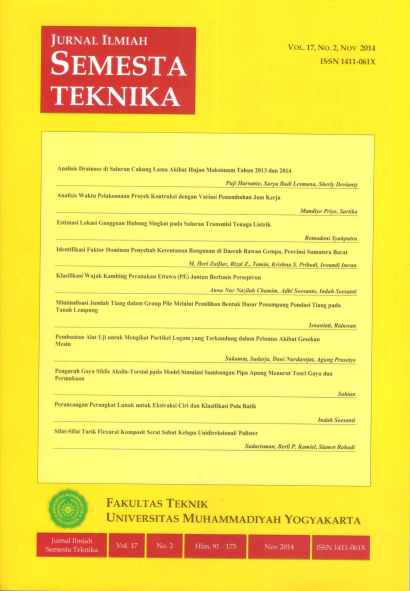Sifat-sifat Tarik dan Flexural Komposit Serat Sabut Kelapa Unidireksional/Poliester
DOI:
https://doi.org/10.18196/st.v17i2.425Abstract
The purpose of this study is to investigate the tensile and flexural properties of unidirectional coconut fiber/polyester composite materials, and to describe their failure modes. Specimens were cut from fiber/polyester composite plates containing various fiber contents. Materials being used in this study are coconut fiber that was previously alkali-treated and polyester resin matrix. Whilst tensile testing was carried out in accordance with the ASTM D3039 standard, flexural testing was based on the ASTM D790 standard. Failure surfaces of the representative specimens were then observed under an optical microscope, and their digital photo macrographs were captured for image analysis in order to describe their respective fiber distribution pattern and to determine their respective actual fiber volume fraction, Vf, by means of an open source software called ImageJ. It was found out that the actual Vf of the four composite plates being produced were 10.7%, 17.6%, 27.4% and 40.5%. It was revealed that while tensile strength increases with the increase of Vf, while failure strain, modulus elasticity and flexural strength decreases. The average highest tensile strength, tensile failure strain, and tensile modulus of elasticity were found being 30.01 MPa at Vf = 40.5%, 0.027 mm/mm at = 0%, and 1.47 GPa at Vf = 0%, respectively. The average highest flexural strength, failure strain and modulus of elasticity were observed being 153.92 MPa at Vf = 10.7%, 0.0358 mm/mm at Vf = 0%, and 3.242 GPa at Vf =10.7%, respectively. It was observed that specimens were failed by fiber pull out and debonding.
Downloads
Published
How to Cite
Issue
Section
License
Semesta Teknika is licensed under a Creative Commons Attribution 4.0 International License.
Authors who publish with this journal agree to the following terms:
- Authors retain copyright and grant the journal right of first publication with the work simultaneously licensed under a Creative Commons Attribution License that allows others to share the work with an acknowledgement of the work's authorship and initial publication in this journal.
- Authors are able to enter into separate, additional contractual arrangements for the non-exclusive distribution of the journal's published version of the work (e.g., post it to an institutional repository or publish it in a book), with an acknowledgement of its initial publication in this journal.
- Authors are permitted and encouraged to post their work online (e.g., in institutional repositories or on their website) prior to and during the submission process, as it can lead to productive exchanges, as well as earlier and greater citation of published work (See The Effect of Open Access).









